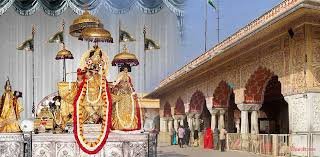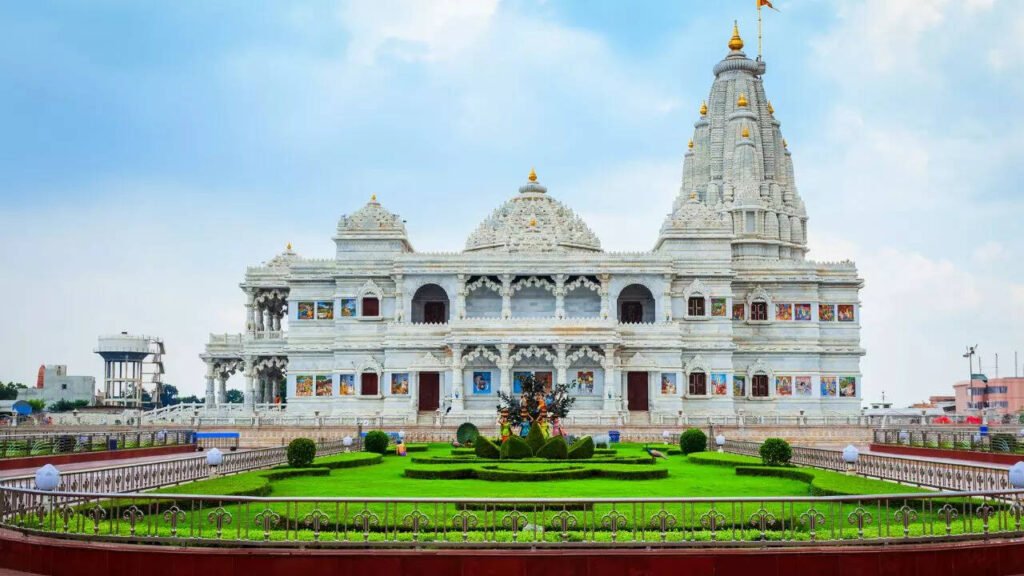The Govind Dev Ji Temple stands as one of India’s most revered Krishna temples, attracting countless visitors with its blend of devotion, architectural beauty, and deep-rooted history. Located in the heart of Jaipur’s City Palace complex, this temple is not just a spiritual site but a living touchstone of heritage, culture, and royal patronage.
Location and Route Information
Govind Dev Ji Temple lies at Jalebi Chowk, within Jai Niwas Garden, in the core of Jaipur’s City Palace complex. The temple’s central location makes it easily accessible:
- By Car/Taxi: About 15 kilometers from Jaipur’s Airport; 4.2 km from the main railway station (approx. 4-minute taxi ride)
- By Bus: City buses run from Jaipur Station to Chhoti Chaupar, followed by a short walk
- By Subway: Jaipur Metro to Chhoti Chaupar, then a brief stroll to the temple
The temple is open to all without an entry fee and is a must-visit spot in Jaipur.
Key Details:
History of Govind Dev Ji Temple
The story of Govind Dev Ji Temple is as dramatic as it is inspiring. According to legend, the central idol, known as Bajrakrit, was crafted by Bajranabh, the great-grandson of Lord Krishna, following the descriptions by his grandmother. This sacred image was later rediscovered in 1525 by Srila Rupa Goswami, a prominent Gaudiya Vaishnava saint, in Vrindavan.
During the period of Mughal Emperor Aurangzeb, Hindu temples faced desecration, and the idol was transported secretly from Vrindavan to Jaipur for safety through an extraordinary journey by loyal devotees. Maharaja Sawai Jai Singh II, the founder of Jaipur, received a divine vision to enshrine the idol at Suraj Mahal, predating even Jaipur’s own foundation. Eventually, the temple itself was constructed in 1735 within the City Palace as a permanent home for the deity and came to symbolize the city’s spiritual identity.
Architectural Marvel and Unique Features
Govind Dev Ji Temple’s architecture skillfully marries Hindu, Mughal, and even western influences. The temple features red sandstone, intricate silver work, and gold-cased ceilings. Striking European chandeliers and Rajasthani paintings line its walls, while magnificent gardens, such as Takatora, surround the precincts.
Positioned strategically within the City Palace, the temple allowed Maharajas to view the deity directly from Chandra Mahal, reflecting the close relationship between the Jaipur royal family and Lord Govind Dev Ji.
- Length: 117 feet (East-West)
- Width: 105 feet (North-South)
- Entry fee: No charge
- Visiting time: Early morning till late night (with multiple aartis daily)
Festivals, Culture, and Daily Rituals
The temple is renowned for its vibrant festivities, none more so than Janmashtami, Lord Krishna’s birthday, when thousands of devotees travel from all over India for grand celebrations. Daily life at the temple features seven aartis, each a musical and spiritual event in itself.
The temple’s culture weaves together lore, artistic traditions, and music, a reflection of Rajasthan’s larger tableau. The religious discourse and “bhajans” (devotional songs) fortify its role as a center of Vaishnava spirituality.

Tourist Significance
Govind Dev Ji Temple is a highlight for those visiting Jaipur, thanks to its spiritual ambiance, bright celebrations, and historical legacy. The well-manicured gardens, adjoining City Palace attractions, and vibrant bazaars nearby make it a favorite among pilgrims, historians, and casual tourists alike.
Nearby attractions to enhance the visitor experience include:
Temple Revenue and Recent Developments
The temple complex is supported as a registered public trust and has received significant funding for modernization and development, including a recent allocation of ₹100 crore by the Rajasthan government to enhance surrounding infrastructure, a move inspired by the Kashi Vishwanath and Mahakaleshwar temple corridors.
Revenue streams include voluntary donations, offerings, and annuities, making it a self-sustaining spiritual institution. No mandatory tickets or fees are imposed on devotees.
Recent News: Temple in the Spotlight
Govind Dev Ji Temple recently featured in the news as Rajasthan’s Chief Minister Bhajanlal Sharma, on Janmashtami, visited along with thousands of devotees, highlighting the temple’s ever-growing cultural and political relevance in the state. Announced development projects promise improved amenities and accessibility, echoing the site’s enduring importance.
FAQs About Govind Dev Ji Temple
Where is Govind Dev Ji Temple located?
Govind Dev Ji Temple is situated within the City Palace complex at Jalebi Chowk, Jai Niwas Garden, Jaipur, Rajasthan.
What is special about the idol at Govind Dev Ji Temple?
The idol, “Bajrakrit,” is believed to have been crafted by Lord Krishna’s great-grandson and is said to bear the most accurate likeness to Krishna’s human form.
What are the best times to visit?
The temple is vibrant year-round but Janmashtami (August/September) is especially spectacular, with unique rituals, music, dances, and large crowds. Opening hours range from 4:30 AM to 9:00 PM, with several daily aartis.
Is there an entry fee, and what are the timings?
There is no entry fee. Timings generally are 5:00 AM – 9:00 PM, with extended aarti sessions and special schedules on major festivals.
How can visitors reach the Govind Dev Ji Temple?
Accessible by car, bus, taxi, or Jaipur Metro to Chhoti Chaupar followed by a short walk.
What is the temple’s historical significance?
The temple’s roots trace to Vrindavan and the Mughal era, with the idol secretly moved to Jaipur for protection. The temple has been the spiritual nucleus of Jaipur since its foundation, supported by royal patronage.
Are there facilities for tourists and devotees?
Yes, the temple and surrounding palace complex include gardens, meditation areas, shops, and accessibility facilities.
What recent renovations are underway?
The Rajasthan government has approved over ₹100 crore for development and beautification, including new corridors and improved public amenities.
Janmashtami 2025: Unprecedented Festivities and Cultural Convergence
In August 2025, Govind Dev Ji Temple once again became the epicenter of devotion and heritage during Janmashtami, drawing unprecedented crowds from across India. The presence of Rajasthan’s Chief Minister Bhajanlal Sharma, alongside religious leaders and thousands of devotees, underscored the temple’s stake in both culture and state identity.
The introduction of a ₹100 crore development corridor, modeled after nationally prominent temple streets in Varanasi and Ujjain, further enhances the temple’s infrastructure, promising wider lanes, beautified visitor zones, and improved facilities for worshippers and travelers alike.
This government-backed initiative is set to increase annual tourism revenue, foster cultural events, and cement Jaipur’s reputation as a national pilgrimage destination.
